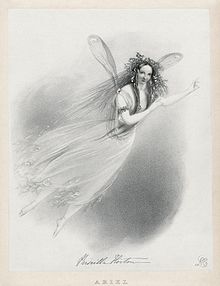Annotation:Sylph (The)
X: 1 C:Page 28 T:Self [2]. MBe.55, The S:Matthew Betham MS, Towcett Cumbria, 1815 O:England;Cumbria;Towcett Z:VMP - Hugh Taylor, 2012 T:Sylph,aka. MBe.55, The M:6/8 L:1/8 Q:3/8=120 R:.Jig N:Someone has written in a different hand alongside the title, "Sylph" N:Sylph is a mythological creature in the Western tradition, associated with invisible beings/Fairies etc N:A reference that may be of interest. "More than 40 members of [the] Lakeland Dialect Society attended the N:first meeting of the year, at Greenodd, near Ulverston. Miss Clara Boyle, of Ambleside, pressed for the N:inclusion of Cumbrian dances and eventually in 1932 the Westmorland Six Reel was accepted, however it was N:renamed 'The Sylph.' much to the disgust of a man from Bowness who wrote a letter of protest in dialect to N:The Westmorland Gazette" [the local weekly newspaper]. K:D A|AFA dfa|agf e2 g|fag fed|cee e2 A| AFA dfa|agf e2 g|fad egA|edd d3:| |:g|fad' d'c'b|bag f2 d|fad fad|cee e2 g| fad' d'c'b|bag f2 d|fad egc|edd d3:|
SYLPH, THE. AKA and see "Plymouth Lasses," “Self (2) (The).” English, Jig (6/8 time). D Major (Hardings): C Major (Ashman). Standard tuning (fiddle). AABB. A sylph was a kind of fairy; winged, kindly disposed to humans, often depicted as tiny cherubs. The title, however, is probably derived from a pantomime called The Sylphs; or, Harlequin’s Gambols, staged at Covent Garden in 1774. The music for the production was by John Abraham Fisher (1744-1806), an English violinist and composer who began his career playing in London theatre orchestras, but who rose quickly to lead the Covent Garden orchestra (from c. 1769-1778). He wrote for the theatre, composed violin pieces, six symphonies and an oratorio, and also penned popular pleasure-garden songs. For a time he led the Vauxhall Garden orchestra.

The melody appears in a number of 19th century English musician’s manuscripts under titles such as “The Self” (Joshua Gibbons,a miss-hearing of 'Sylph'), “The Sylph” (John Clare, John Moore), “The Cylph Dance,” etc., in a variety of keys. Moore gives the alternate title “Plymouth Lasses.” The jig also appears in the music manuscripts of Lionel Winship (Wark, Northumberland, 1833), Rev. Robert Harrison (Brampton, Cumbria, 1820), John Moore (Tyneside, 1841), the Hardy family (Dorset), William Calvert (Leyburn, north Yorkshire, 1812), John Baty (Bethel, Northumberland, 1840-60), Thomas Lambert (Ferrybridge, Yorkshire) and C.J. Surtees (Northumberland). In America the tune was published in Willig’s Collection of Popular Country Dances, No. 3 (Philadelphia, Pa., 1812), and dance instructions were given in a few other publications.
